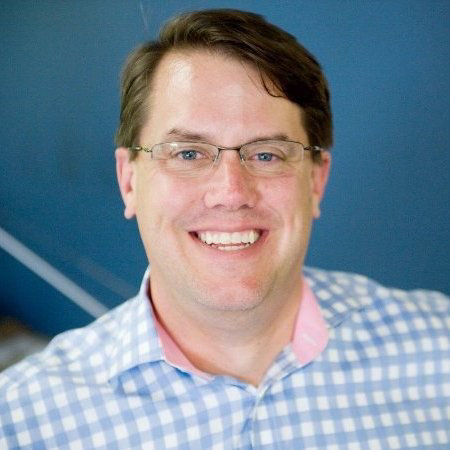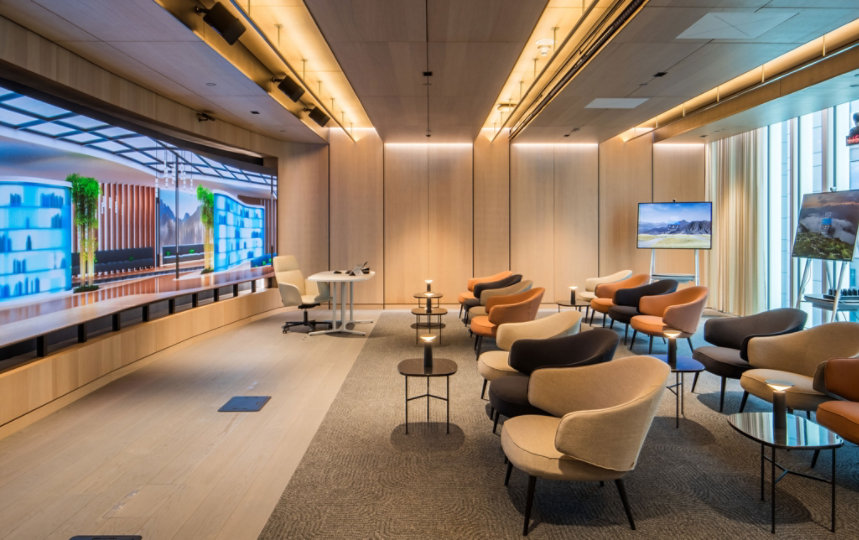“When you walk into a space, either there is magic or there is not,” says Powlo, one of the leads for the Hub program, clutching a book by lighting designer Bentley Meeker. “And when you walk into an Hub, there has to be magic.”
Meeker, presumably unaware of his creative influence on one of Microsoft’s top sales programs, is one of many unusual inspirations from outside the traditional corporate world for this small group of business-minded creatives who bring Microsoft Innovation Hub to life in 40+ locations.
On an evening in June, Powlo was joined by some of the rest of the Hub global leadership team to give a more in-depth look at the people behind the innovation.
Joining him were Eric Hurt, Immersive Experience Lead; Shawna Flemming, Director for Partners, and Craig Dillon, Worldwide Lead for the Hub program. They are tight knit crew. Greetings are warm and sincere.
This is actually Craig’s second tour as lead. He was part of the Microsoft Technology Center inaugural team in 2001 - credited within Microsoft as having the initial inspiration for a space that used immersive technology and extensive discovery to set the stage for unprecedented digital transformation.

Eric Hurt
Immersive Experience & Storytelling Lead
"Each Hub works in a totally different mindset when it comes to customer engagements. They're doing rapid prototypes, hackathons, they're building a solution for a customer live and in real time.
How can you quickly catch the attention of somebody but talk about the technology in a way that makes sense? For me it's touch, see, feel, do. It's all the tactile senses. It’s the physicality of bringing technology partner solutions and first party solutions to life in a way that someone can experience in as many ways possible.
I think of the Hub storytelling as going from 10,000 feet – setting the broad landscape – all the way to a deep dive. Behind the scenes of the whole technology stack.
That’s truly what the clients of the Hub are looking for. So designing content, experiences for both breadth and depth is a really hard challenge.
Obviously we want to be super creative, we want to tell an engaging story, but the constraint is we can’t just go wild and design some immersive technical fantasy - the storytelling and the demos have to be real. Customers can smell a fake demo a mile away and it just creates this sort of polite awkwardness where you’ve lost them. We’ve all been there. So it's got to be 100% credible.
Shawna's work with partners really helps. Partners lend an automatic credibility because their commercial products work in the real world."

Shawna Flemming
Director for Partners, Customer Experience Team
"Partners make it real. They give us credibility and they give us scale.
When a customer's coming in, thinking, ‘OK, how do I bring innovation into my business?’ They don't really understand until they see it, and they see it a lot of times, through partner solutions.
When our technical architects in their engagements have an envisioning session or strategy session, they’ll customize an agenda for each one. An hour of that agenda might be dedicated to a partner solution because it is perfect for showing what the customer is trying to achieve.
And retail, for example, can be shown to a financial institution. Customers actually want to see what other industries are doing, and to learn.
So even though it's set up by industry to help with those conversation starters with the customer, a lot of times we do showcase cross industry because we are cross technology anyway.
Our TAs don't just talk about one solution. We can have five solutions brought in depending on what we're trying to drive with that customer.
I’m looking to make sure we have the right content for those conversations, and where it makes sense the right physical demos for them as well. Every partner wants to be in Hub – who wouldn’t – so it’s also about editing down that vast opportunity and making sure we have the right partners in the right places. If you’re in New York you want to talk finance, if you’re in Boston you want to talk Healthcare. Munich you might be leaning to manufacturing. So all that gets factored in."

Powlo
Technical Architect Lead
"So a new topic comes along – take something like artificial intelligence – obviously a huge interest area for customers right now and an area where Microsoft has a great story to tell - we’re the people who are going to get together and think, ‘OK. How do we make this as engaging and persuasive as possible for our customers?
Eric's thinking about how we do that so it’s on brand, with a level of materials quality, marketing clarity, on a global scale at a cost point that's going to work everywhere.
Shawna is thinking about that from the perspective of ‘which of my many partners has the best solution that's going to convince people, that’s going to be credible, and that's actually going to be useful to lower the cost of a customer doing this themselves.
And then I'm thinking about it from the perspective of how we build our facilities and platforms to make all this work. Foundation stuff like facility design and build, and also the digital backbone for our demos and training and readiness which underpins that globally.
We’re planning a refresh of Sydney at the moment so I’m on a lot of early morning calls obsessing the details. What are the sight lines when you walk around the space? How is that demo going to be filmed for a virtual engagement? How is the acoustics going to work if we have two customers at once? You can’t use a corporate design firm and say ‘build a nicer meeting room for our top clients’. You have to brief it differently. We use architecture firms who build high-end hospitality, hotels, cruise ships, theme parks."

Craig Dillon
Worldwide Lead, Microsoft Innovation Hub
"Our technology centers reflect who we are as a company.
The purpose was to drive a different outcome for our customers, and that's still very true today. We're consultants to our customers to help them create solutions that exactly meet their needs.
And what does that do? It enables Microsoft to deliver business outcomes for our customers.
And how do we do that? We do that with immersive experiences that challenge, sometimes provoke, that provide them new ways of thinking about capabilities from Microsoft, and our partners, to enable them to create new businesses, to enable greater collaboration of employees across the world to create greater productivity.
That has always been our core goal and our purpose as a team throughout the years."
It’s a unique balancing act: a consistent focus on enduring ideals while staying ahead of technology’s exceedingly high rate of change. Technical Architects immersing themselves in a client’s challenges to in turn surround them with solutions. Magic, indeed.

